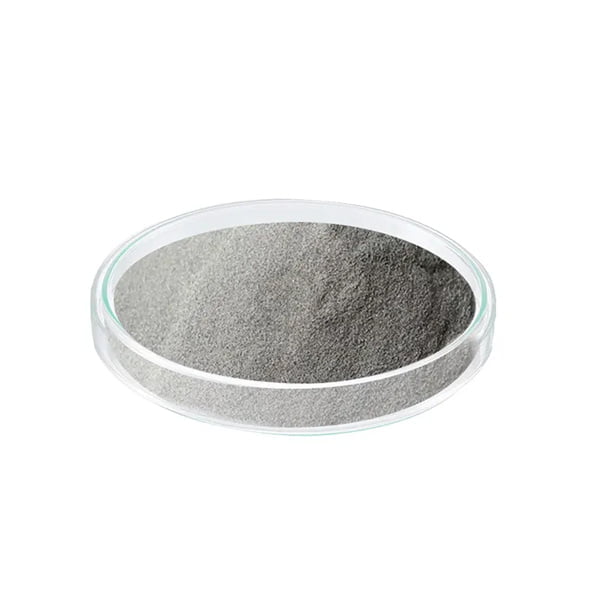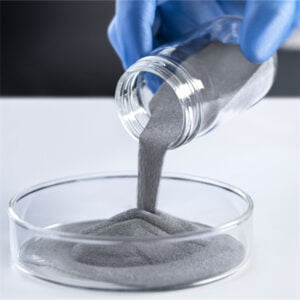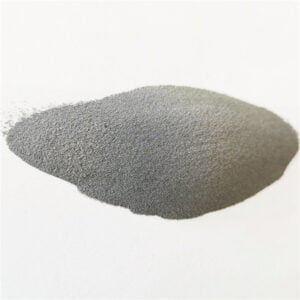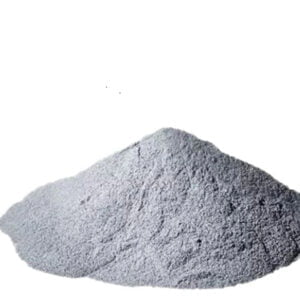Výroba kovového prášku
Obsah
Přehled
Kovové prášky jsou jemné kovové částice, které se používají jako vstupní surovina pro výrobní techniky, jako je aditivní výroba, vstřikování kovů a lisování a slinování v práškové metalurgii. Výroba pokročilých speciálních kovových prášků s přesnou kontrolou chemického složení, distribuce velikosti částic, morfologie a mikrostruktury má zásadní význam pro vlastnosti hotových součástí.
Pro velkoobjemovou výrobu kovového prášku z různých systémů slitin se používají různé metody, včetně:
- Rozprašování plynu
- Rozprašování vody
- Plazmová atomizace
- Indukční tavení elektrod a rozprašování plynu
- Proces rotační elektrody
- Karbonylový proces
- Elektrolytický proces
- Procesy redukce kovů
Výsledkem každého procesu jsou prášky s různými vlastnostmi vhodnými pro konkrétní aplikace.
Způsoby výroby kovového prášku
| Metoda | Použité kovy | Klíčové vlastnosti | Hlavní aplikace |
|---|---|---|---|
| Atomizace plynu | Titan, hliník, nerezová ocel, nástrojová ocel, superslitiny | Sférické prášky, střední rychlost výroby | Vstřikování kovů, izostatické lisování za tepla |
| Atomizace vody | Nízkolegovaná ocel, železo, měď | Nepravidelné tvary prášku, vyšší obsah kyslíku | Proces lisování a spékání |
| Plazmová atomizace | Slitiny titanu, superslitiny | Velmi jemné sférické prášky | Aditivní výroba |
| Rotační elektroda | Wolfram, molybden, tantal | Řízená struktura zrna | Vlákna, řezné nástroje |
| Karbonylový proces | Železo, nikl, kobalt | Ultrajemné prášky vysoké čistoty | Elektronické součástky, magnety |
| Elektrolytické | Měď, nikl | Morfologie dendritických vloček | Povrchové nátěry |

Kovový prášek Výrobní metody
Pro výrobu kovových prášků z různých systémů slitin se používá řada komerčních metod. Volba výrobní metody závisí na faktorech, jako jsou:
- Typ materiálu slitiny
- Požadavky na čistotu
- Požadované vlastnosti prášku, jako je velikost částic, tvar, struktura zrn.
- Rozsah výroby v tunách za rok
- Konečné použití prášku
Zde jsou uvedeny některé z nejběžnějších průmyslových procesů výroby kovového prášku:
Proces atomizace plynu
Při plynové atomizaci se proud roztavené kovové slitiny rozkládá vysokotlakými proudy plynu, obvykle dusíku nebo argonu. Proud kovu se rozpadá na jemné kapičky, které tuhnou na částice prášku.
Plynem atomizované prášky mají kulovitý tvar a hladkou morfologii povrchu. Distribuci velikosti částic lze řídit nastavením procesních parametrů. Jedná se o široce používanou techniku pro reaktivní materiály, jako je titan, hliník, hořčíkové slitiny, ale i nerezové oceli, nástrojové oceli a niklové superslitiny.
| Parametr | Popis |
|---|---|
| Použité kovy | Slitiny titanu, hliníku, hořčíku, nerezové oceli, nástrojové oceli, superslitin |
| Tvar částic | Sférická morfologie |
| Velikost částic | Typicky 50 - 150 μm |
| Čistota | Vysoký obsah inertního plynu zabraňuje kontaminaci |
| Vyzvednutí kyslíku | Minimální ve srovnání s atomizací kapalného kovu |
| Rozsah výroby | Až 10 000 tun ročně |
Atomizace vody
Při vodní atomizaci je proud roztaveného kovu zasažen vodním paprskem o vysoké rychlosti. Náhlé ochlazení způsobí explozi, která rozbije kov na jemné částice. Prášky mají nepravidelný tvar a obsahují vyšší obsah kyslíku z kontaktu s vodou.
Vodní atomizace je levnější proces používaný pro výrobu velkých objemů nerezové oceli, legované oceli, železa a měděného prášku pro lisování a slinování.
| Parametr | Popis |
|---|---|
| Použité kovy | Uhlíkové oceli, nízkolegované oceli, nerezové oceli, měď, železný prášek |
| Tvar částic | Nepravidelná morfologie způsobená explozivním rozpadem vody |
| Velikost částic | 10 - 300 μm typicky |
| Čistota | Nižší, kontakt s vodou zvyšuje hladinu kyslíku o 200-500 ppm. |
| Rozsah výroby | Velmi vysoký, více než 50 000 tun ročně |
Proces plazmové atomizace
Při plazmové atomizaci se k roztavení kovové slitiny před rozpadem na jemné kapičky pomocí proudů plynu používá plazmový hořák. Velmi vysoké teploty umožňují úspěšnou atomizaci vysoce reaktivních prvků, jako jsou například aluminidy titanu.
Prášky mají velmi kulovitý tvar a úzkou distribuci velikosti vhodnou pro aditivní výrobní metody, jako je tavení laserem a tavení elektronovým svazkem.
| Parametr | Popis |
|---|---|
| Použité kovy | Slitiny titanu, superslitiny niklu, aluminidy titanu |
| Tvar částic | Vysoce sférický |
| Velikost částic | Typicky 15 - 45 μm |
| Čistota | Velmi vysoká čistota díky tavení v inertní atmosféře |
| Rozsah výroby | Nižší, asi 100 - 1000 tun ročně |
Proces rotačních elektrod (REP)
Při procesu s rotující elektrodou se válcová kovová elektroda otáčí vysokou rychlostí v evakuované komoře. Ta se taví pomocí elektrického oblouku a kapičky roztaveného kovu, které jsou odstředivými silami odlétávány, se ochlazují a vytvářejí prášek.
Prášky REP mají ideální strukturu a morfologii zrn pro vytlačování za tepla do jemných drátů a tyčí pro letecké slitiny, jako je wolfram, molybden a tantal.
| Parametr | Popis |
|---|---|
| Použité kovy | Wolfram, molybden, tantal |
| Tvar částic | Nepravidelná, kontrolovaná mikrostruktura |
| Velikost částic | Typicky 45 - 150 μm |
| Čistota | Velmi vysoká ze zpracování ve vakuu |
| Rozsah výroby | Malé objemy prášků s vysokou hodnotou |
Elektrodová indukční atomizace plynem (EIGA)
Proces EIGA využívá indukční ohřev k tavení spotřebních elektrodových hrotů v atmosféře inertního plynu. Kapky jsou sekundárně rozprašovány argonovými tryskami na jemný sférický prášek.
EIGA umožňuje velmi vysokou čistotu reaktivních niklových superslitin pro kritické letecké komponenty díky řízenému tavení a minimalizaci kontaminace.
| Parametr | Popis |
|---|---|
| Použité kovy | Superslitiny niklu, aluminidy titanu |
| Tvar částic | Sférické |
| Velikost částic | 15 - 53 μm typicky |
| Čistota | Extrémně vysoký, přizpůsobený pro kritické slitiny |
| Rozsah výroby | Výzkum a vývoj/prototypování až po středně velké objemy |
Karbonylový proces
Při karbonylovém procesu se kov přeměňuje na těkavý karbonyl, který se za řízených podmínek rozkládá za vzniku rovnoměrných, velmi jemných kovových částic. Tento postup je vhodný pro výrobu vysoce čistých prášků železa, niklu a kobaltu.
| Parametr | Popis |
|---|---|
| Použité kovy | Železo, nikl, kobalt |
| Tvar částic | Sférické až polyedrické |
| Velikost částic | Typicky 1 - 10 μm |
| Čistota | Extrémně vysoká čistota 99,9%+ |
| Rozsah výroby | Až 30 000 tun ročně |
Další metody výroby prášku
Mezi další techniky používané pro výrobu speciálních kovových prášků patří:
- Elektrolytický proces: Používá se k výrobě měděných a niklových prášků nepravidelného tvaru s dendritickou morfologií procesem elektrodepozice.
- Procesy redukce kovů: Redukce oxidů kovů pomocí vodíku nebo uhlíku za účelem výroby prášků titanu, zirkonia, wolframu a molybdenu.
- Mechanické legování: Vysokoenergetické kulové mletí pro syntézu kompozitních a nanostrukturních slitin
Kovový prášek Specifikace
Kritické atributy kvality a specifikace testované u kovových prášků závisí na způsobu výroby a konečném použití, ale obvykle zahrnují:
Chemie prášků
- Složení slitiny pomocí optické emisní nebo rentgenové fluorescenční spektroskopie
- Drobné legující prvky
- Příměsové prvky jako kyslík, dusík, vodík
- Zkouška ztráty žíháním při vysoké teplotě
Distribuce velikosti částic
- Objemová střední velikost částic
- Šířky rozdělení jako D10, D50, D90
Charakterizace tvaru částic
- Skenovací elektronová mikroskopie pro morfologii
- Tvarové faktory, jako je poměr stran a tvarový faktor
Mikrostruktura
- Přítomné fáze pomocí rentgenové difrakce
- Charakteristiky zrna ze zobrazování
Vlastnosti prášku
- Zdánlivá hustota/hustota odběru
- Průtokové rychlosti při zkouškách nálevkou Hallova průtokoměru
- Úrovně stlačitelnosti
Požadavky na specifikace prášků se značně liší v závislosti na konečném použití v různých aplikacích:
| Parametr | Vstřikování kovů (MIM) | Aditivní výroba | Lisování a spékání |
|---|---|---|---|
| Rozsah velikosti částic | 3 - 25 μm | 15 - 45 μm | 150 - 300 μm |
| Poměr stran | 1 - 1,25 přednostně | <1,5 sférického | Není kritické |
| Hladiny kyslíku | <1000 ppm | <500 ppm | 2000 - 4000 ppm |
| Zdánlivá hustota | >2,5 g/cm3 | >2,8 g/cm3 | 2 - 3 g/cm3 |
| Hallův průtok | 15 - 35 s/50 g | 25 - 35 s/50 g | >12 s/50g |
Metody charakterizace
Existuje několik analytických metod, které se používají k charakterizaci vlastností kovových prášků nezbytných pro výkonnost výrobku:
Analýza velikosti částic
K charakterizaci distribuce velikosti částic se nejčastěji používají metody laserové difrakce. Při této technice prochází laserový paprsek rozptýleným vzorkem prášku, který rozptyluje světlo pod úhlem závislým na velikosti částic. Počítačová analýza difrakčního obrazce poskytuje během několika sekund podrobné statisticky relevantní údaje o distribuci velikosti.
Morfologie a zobrazování povrchu
Rastrovací elektronová mikroskopie (SEM) poskytuje snímky tvaru částic prášku, topografie povrchu a vlastností s vysokým rozlišením při mnohem větším zvětšení a hloubce ostrosti než optická mikroskopie.
Zobrazení SEM se používá ke studiu zaoblení částic, tvorby satelitů, hladkosti povrchu a defektů, jako je pórovitost.
Měření hustoty a průtokových vlastností
Byly zavedeny standardní zkušební metody pro kvantifikaci objemového chování pomocí:
- Hallův průtokoměrný trychtýř k měření průtoku prášku clonou
- Carneyho trychtýř k posouzení průtočnosti podle úhlu sklonu
- Scottův volumetr pro stanovení hustoty a stlačitelnosti kohoutku
Tyto metody pomáhají předvídat snadnou manipulaci, míchání, plnění a roztírání při výrobě komponent.
Rentgenové metody pro stanovení složení a krystalové struktury
- Rentgenová fluorescenční spektroskopie přesně identifikuje a kvantifikuje prvkové složení kovů.
- Rentgenová difrakce analyzuje uspořádání atomů a přítomné fáze pomocí difrakčních píků.
-
 Ti45Nb prášek pro aditivní výrobu
Ti45Nb prášek pro aditivní výrobu -
 Prášek ze slitiny TiNb
Prášek ze slitiny TiNb -
 Prášek ze slitiny TiNbZrSn
Prášek ze slitiny TiNbZrSn -
 Ti6Al4V prášek Kovový prášek na bázi titanu pro aditivní výrobu
Ti6Al4V prášek Kovový prášek na bázi titanu pro aditivní výrobu -
 CPTi prášek
CPTi prášek -
 TC18 Powder : Odemknutí síly karbidu titanu
TC18 Powder : Odemknutí síly karbidu titanu -
 TC11 Powder: Komplexní průvodce
TC11 Powder: Komplexní průvodce -
 TC4 ELI prášek
TC4 ELI prášek -
 Nejlepší prášek Ti-6Al-4V (TC4 Powder) pro aditivní výrobu
Nejlepší prášek Ti-6Al-4V (TC4 Powder) pro aditivní výrobu
Použití kovových prášků
Mezi hlavní konečná použití technických kovových prášků patří:
Aditivní výroba
Známé jsou také techniky 3D tisku, jako je selektivní laserové tavení (SLM), přímé laserové spékání kovů (DMLS) a tavení elektronovým svazkem (EBM), které umožňují vytvářet složité geometrie z titanu, hliníku, nerezové oceli, superslitin a kobalt-chromových prášků.
Vstřikování kovů (MIM)
Prášky, jako jsou nerezové oceli, titanové slitiny a nástrojové oceli, se kombinují s pojivem, vstřikují se a následně se spékají, aby bylo možné vyrábět malé, složité díly ve velkých objemech při nižších nákladech.
Práškové metalurgické lisy a spékače
Zhutňování a spékání prášků ze železa, mědi a legované oceli do velkoobjemových součástí, jako jsou ozubená kola, pouzdra a magnety.
| aplikace | Použité kovy | Klíčové potřeby nemovitostí |
|---|---|---|
| Aditivní výroba | Slitiny titanu, superslitiny niklu, hliník, nástrojová ocel, nerezová ocel, kobalt-chrom. | Sférická morfologie Dobrá tekutost Vysoká čistota |
| Vstřikování kovů | Nerezová ocel, titan, nástrojová ocel, těžké slitiny wolframu | Jemný prášek <25 μm Dobrá hustota balení |
| Lisování a spékání | Železo, ocel, nerezová ocel, měď | Nákladově efektivní práškové mazací nátěry |
Existují také specifické aplikace v oblastech, jako je svařování, diamantové nástroje, elektronika a povrchové úpravy, které využívají speciální kovové prášky.
Dodavatelé a ceny
Mezi přední světové dodavatele různých kovových prášků patří:
| Společnost | Výrobní metody | Materiály |
|---|---|---|
| Sandvik Osprey | Rozprašování plynu | Slitiny titanu, hliníku a niklu |
| AP&C | Plazmová atomizace | Aluminidy titanu, superslitiny |
| Tesařská technologie | Rozprašování plynu, vody | Nástrojové oceli, nerezové oceli, slitiny |
| Höganäs | Rozprašování vody | Železo, nerezové oceli |
| JFE Steel | Rozprašování vody | Prášky z nerezové oceli |
| Rio Tinto | Hliníkový prášek | Karbonyl niklu a železa |
Ceny kovových prášků se značně liší podle:
- Materiál a složení slitiny
- Použitá výrobní metoda
- Zpracování pro dosažení vlastností částic
- Úrovně čistoty a stupeň kontaminace
- Objem nákupu - smlouvy s velmi vysokým objemem přinášejí nižší ceny.
Typické základní ceny za kilogram jsou:
| Materiál | Odhad ceny |
|---|---|
| Nerezová ocel 316L | $12 - $30 na kg |
| Hliník AlSi10Mg | $15 - $45 na kg |
| Titan Ti-6Al-4V | $80 - $220 za kg |
| Niklová superslitina Inconel 718 | $90 - $250 za kg |
| Speciální slitiny pro AM | $250 - $1000 za kg |
Ceny se výrazně zvyšují v případě vysoce přizpůsobených distribucí velikosti částic, kontrolovaných hladin kyslíku a dusíku pod 100 ppm a nákupů malých šarží.
Výhody a omezení práškové metalurgie
Výhody práškové metalurgie
- Možnost výroby složitých geometrií, které není možné vyrobit odléváním nebo obráběním.
- Výroba téměř síťového tvaru snižuje množství materiálového odpadu
- Lze použít kovy a slitiny s vyššími parametry.
- Konzistentní struktura pórovitosti, která není v metalurgii slitků možná.
- Komponenty lze hromadně přizpůsobit
Omezení výroby a zpracování prášku
- Kapitálové investice do výrobního a manipulačního zařízení jsou velmi vysoké.
- Zvýšená plocha povrchu činí manipulaci s pyroforickými reaktivními prášky riskantní.
- Dosažení vysoké hustoty zhutnění může vyžadovat vysoké tlaky.
- Další kroky procesu ve srovnání s odléváním
- Přenositelnost AM strojů díky prášku LO/NO
Zde je stručné srovnání práškové metalurgie s konvenčním procesem odlévání:
| Parametr | Prášková metalurgie | Casting |
|---|---|---|
| Složité tvary | ✅ Vynikající pro vrstvené sestavy AM | Omezeno pro typické odlitky |
| Mechanické vlastnosti | Může se přiblížit vlastnostem odlitku po izostatickém lisování za tepla | ✅ Předvídatelné vlastnosti |
| Doba cyklu | Pomalejší proces u metod AM | ✅ Rychlejší pro sériovou výrobu |
| Rozměrová přesnost | Různé, závisí na následném zpracování | Velmi dobré pro přesné investiční odlitky |
| Náklady na vybavení | Velmi vysoká pro průmyslové stroje AM | ✅ Nižší investiční náklady |
| Typy kovů | Neustále se rozšiřující možnosti | ✅ Nejširší výběr |

Nejčastější dotazy
Otázka: Jaký je typický rozsah velikosti částic používaných v kovových 3D tiskových prášcích?
Odpověď: U technologií s práškovým ložem, jako je selektivní laserové tavení (SLM) a tavení elektronovým svazkem (EBM), je optimální velikost částic v rozmezí 15-45 mikronů. Jemnější prášky zlepšují rozlišení, ale mohou být náročné na manipulaci a zpracování.
Otázka: Co určuje morfologii kovových prášků z různých metod?
Odpověď: Tvar částic určují výrobní faktory, jako je intenzita rozkladných sil proudu taveniny způsobených proudy plynu nebo nárazy vody, a následná rychlost chlazení. Rychlejší chlazení vytváří nepravidelné, dendritické částice, zatímco pomalejší tuhnutí (sférická atomizace) umožňuje hladké zaoblené struktury.
Otázka: Proč je pro kovové prášky v aditivní výrobě důležitá vysoká čistota?
Odpověď: Nečistoty mohou způsobovat vady, problémy s pórovitostí, měnit mikrostrukturu slitiny, snižovat hustotu, ovlivňovat výkon při zatížení a teplotách - negativně ovlivňovat mechanické vlastnosti. Typickými se staly cílové hodnoty kyslíku pod 500 ppm a dusíku pod 100 ppm.
Otázka: Jak se bezpečně zachází s kovovými prášky při přepravě a skladování?
Odpověď: Reaktivní kovové prášky jsou pasivovány, aby se vytvořil oxidovaný povrch minimalizující riziko vznícení. Prášky jsou během přepravy uzavřeny v sudech pod inertními plyny, jako je argon, namísto vzduchu, aby se zabránilo vznícení. Skladovací nádoby musí být řádně uzemněny. Personál při manipulaci nosí specializované osobní ochranné pomůcky.
Otázka: Jaké jsou běžné metody charakterizace prášku?
Odpověď: Hallova průtokoměrná analýza, testy hustoty odboček, pyknometrie, testování LOI, spektrografická analýza, metalografie a distribuce velikosti částic pomocí laserových nebo sítových technik jsou zásadní pro kvantifikaci chování, vytvoření řízení kvality procesu výroby kovových prášků a posouzení vhodnosti šarže pro dané aplikace.
Sdílet na
MET3DP Technology Co., LTD je předním poskytovatelem řešení aditivní výroby se sídlem v Qingdao v Číně. Naše společnost se specializuje na zařízení pro 3D tisk a vysoce výkonné kovové prášky pro průmyslové aplikace.
Dotaz k získání nejlepší ceny a přizpůsobeného řešení pro vaše podnikání!
Související články

Vysoce výkonné segmenty lopatek trysek: Revoluce v účinnosti turbín díky 3D tisku z kovu
Přečtěte si více "O Met3DP
Nedávná aktualizace
Náš produkt
KONTAKTUJTE NÁS
Nějaké otázky? Pošlete nám zprávu hned teď! Po obdržení vaší zprávy obsloužíme vaši žádost s celým týmem.

Kovové prášky pro 3D tisk a aditivní výrobu
SPOLEČNOST
PRODUKT
kontaktní informace
- Město Qingdao, Shandong, Čína
- [email protected]
- [email protected]
- +86 19116340731















